Can you really eat snow in survival situations?
Snow is like water, but can you eat snow if you're in a survival situation? And if so, you'll find out here what you need to consider.
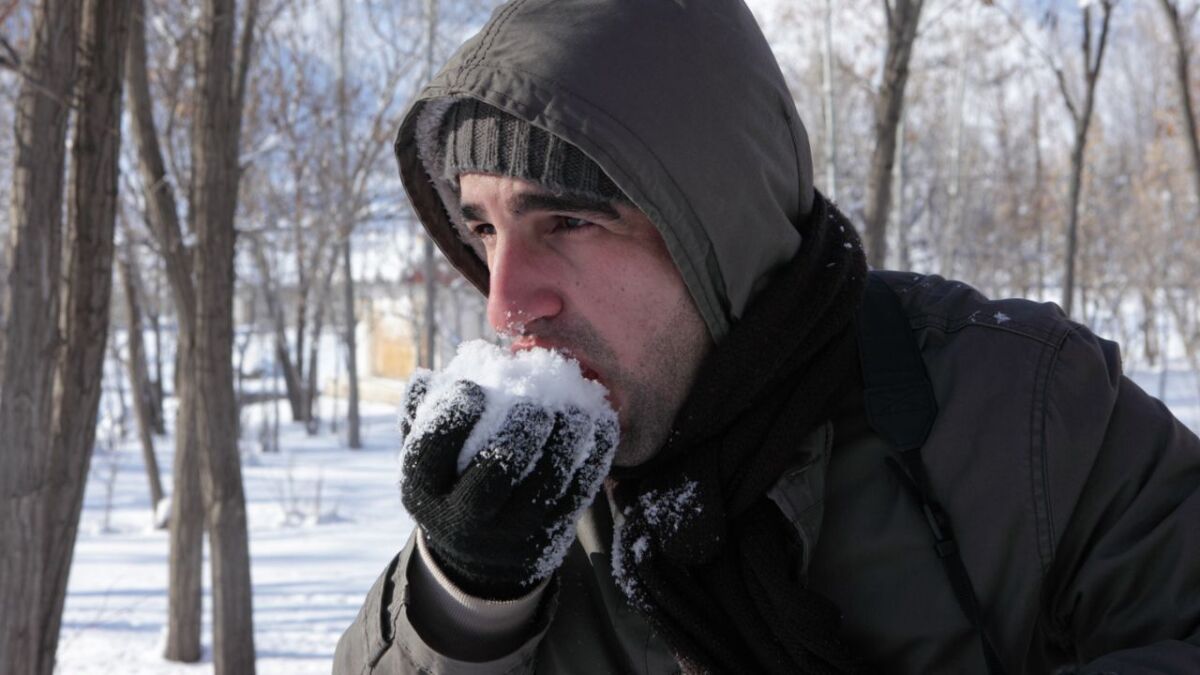

From Martin Gebhardt. Check out my “About me” page.
👉 The key facts from this guide
- Snow as a water source: Snow is frozen water and can therefore be used to meet fluid requirements. However, it should be melted before consumption to avoid poisoning or hypothermia.
- Avoiding contamination: Undiscolored snow is best suited for consumption. In survival situations, pure snow should only be eaten in exceptional cases to avoid hypothermia and contamination.
- Snow melting methods: It is better to collect snow in a container and allow it to melt there before drinking. Alternatively, body heat or sunlight can be used to melt snow.
- Fresh snow is better: The snow should be collected as fresh as possible to avoid contamination from waste or animal feces.
- Nutrient deficiency: Snow should not be used exclusively as a source of water, as it does not provide all the nutrients that the human body needs.
- Avoiding hypothermia: Eating raw snow can lead to further cooling of the body and should therefore be avoided.
To survive in winter, which often means surviving in icy conditions, can be a real challenge.
Harsh conditions, biting cold, and other factors make it much more difficult in many ways than under other conditions. But there must be something positive about it, like the abundance of available water in the form of snow, right?
As you may have learned in numerous articles on my blog, hydration is one of the most important points to consider in survival situations.
Accordingly, you might think, "Snow is simply frozen water, so it's ideal for hydration!" So, can you really eat snow in survival situations?
For a quick overview
I would rather not keep you waiting too long, so I'll give you the answer right away to the question: Can you really eat snow in survival situations?
You can eat snow. However, make sure that there are no discolorations (don't eat yellow snow). Additionally, you should melt the snow before consuming it. Failure to do so could lead to contamination or hypothermia.
If you want to play it safe and get all the information on this topic, read on now.
Eat the snow without eating the snow
The title may sound confusing and contradictory, but you'll soon understand what I mean. So don't be discouraged and allow me to explain.
Unless in absolute emergencies, you should not just grab snow and consume it, meaning literally eating it.
Only do that if you're at risk of dehydration. Although that can do you more harm than good eventually, it's better to live a little longer and see what else there is, right?
Sure, snow quickly provides you with a significant amount of fluid, which will help you at that moment. However, the negative effects should not be underestimated.
So that you know what I am talking about, I will list these negative effects for you in detail. At the end of the text, you will be able to decide for yourself whether it is worth it for you to eat (pure) snow or not.
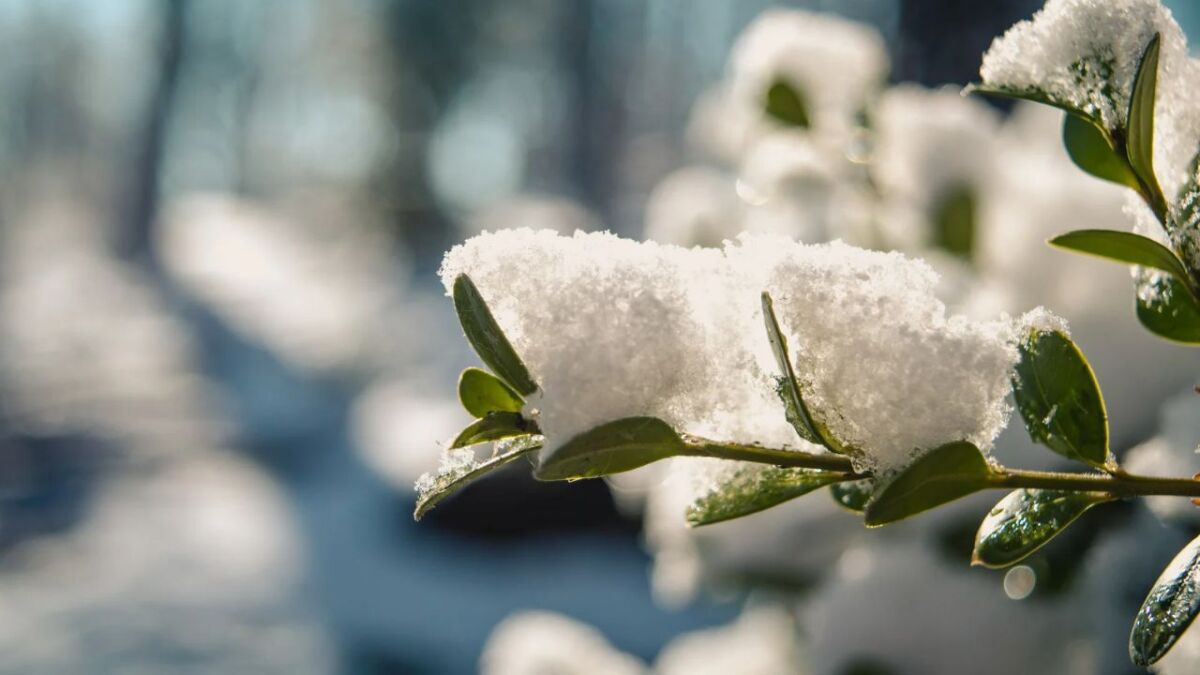
Numbness and pain
I admit, this negative effect fades when it comes to bare survival - nevertheless, I mention it. You know the feeling when you bite into ice and do it repeatedly?
Eventually, it becomes very painful in your mouth, especially on your teeth. With all the problems you are currently experiencing, you don't need numbness or pain in your mouth area. That's exactly what can happen when snow enters your mouth.

Do you also know the typical "brain freeze"? If you eat ice too quickly, or drink a cold drink in just one sentence, sudden, severe headaches can result.
If you eat snow, probably even several "pieces", you can expect exactly that. In the worst case, the pain is so strong that it incapacitates you. You also want to avoid that.
Whether and to what extent the factors of numbness and pain affect you is entirely up to you. Depending on how precarious the situation you are in, quick decisions are required that do not allow hesitation.
Contamination
Next, I come to a point that you should definitely take more seriously: contamination.
Forgive me for being direct, but would you take a large gulp from a bottle of water that has been contaminated with dirt or even fecal matter? Probably not, and that's a good thing. After all, you would rather not suffer any health problems.
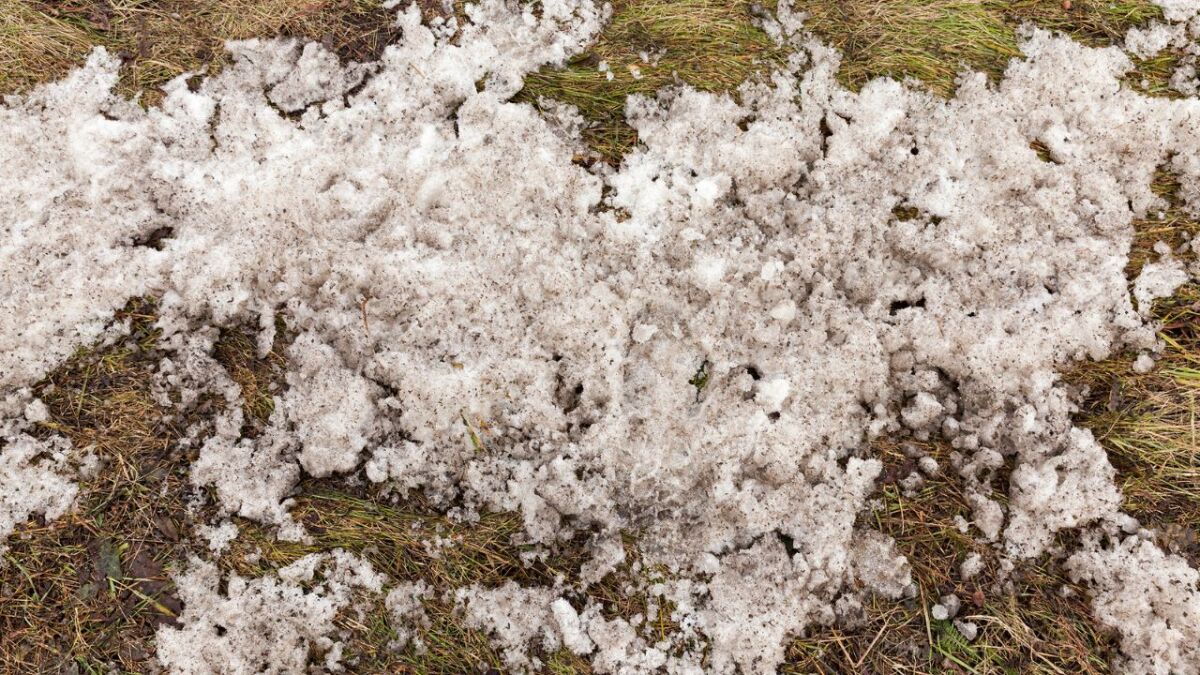
Snow is similar to this. Please keep in mind that many wild animals move on it and can thus contaminate it.
Whether it's urine, feces, or remnants of carcasses, you don't want any of it in your body. So, always take a close look at the snow to see if it has any discolorations or other characteristics.
It may not be pleasant, but you must always keep this factor in mind if you are in a winter survival situation. The last thing you need are diseases that you could have avoided with a little caution and attention.
Hypothermia
Now let's talk about perhaps the most important factor against eating "raw" snow: hypothermia, or the cooling of your body.
To summarize: you are in icy cold weather, the wind is biting at your limbs and is also stealing the last bit of body heat from you.
What is your goal now? That's right, you need to warm your body and prevent all its functions from failing due to the cold over time!
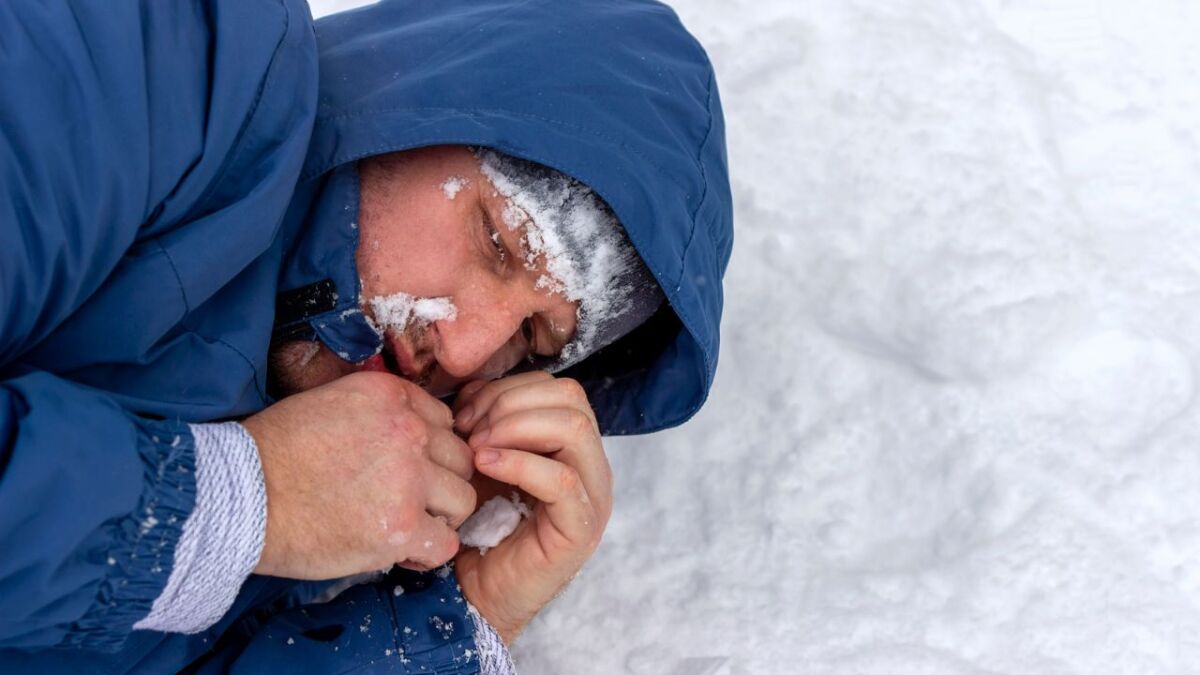
Would you therefore come up with the rather unfavorable idea of eating ice in this situation? Probably not, right? And why not? Clearly, it cools your body additionally from the inside out.
It's the same with snow. Keep in mind: snow is cold, freezing. If you consume it without thawing it and warming it up accordingly, it will enter your system as cold as you found it.
Depending on the amount of snow consumed, this can lead to an even stronger and faster drop in your body temperature. This, in turn, can be deadly.
I know, you're thirsty and need to drink something urgently. On the other hand, you also can't freeze to death. It's like choosing between the devil and the deep blue sea, you really can't win. Damage control and survival is the motto.
Read also
Survival in winter - these tips are important in the cold - Winter weather and cold represent major challenges in survival. To avoid unnecessary risks, you must plan carefully in advance.
Surviving in the cold - a little reflection
Before I explain how to make snow drinkable, I would like to address another point regarding survival in the cold that I consider significant. It is always essential to me that my readers can take away added value from my articles, and so it is here as well.
Most survivalists are convinced that water is the absolute top priority when it comes to bare survival.
Basically, this is correct because we don't survive long without water. This is particularly true in warmer or very hot regions, where the body's need for fluid can often become enormous.
In a bitterly cold environment, however, this can change a bit. Water is still incredibly important, no question about it. But here, the cold sits in the back of your neck, gradually wearing out your body and, in the worst case, causing your organs to fail and you to die.
So, protection from the cold should be your top priority here.
You can only survive for a few days without water, that's correct. But exposed to icy without protection, you will only survive for a few hours.
Keep this in mind for all survival scenarios you may experience in a bitterly cold environment. If you are keen to learn more about survival in the cold, I have two articles for you:
- Building & Igniting a Fire in the Snow - The Complete Guide
- Camping in a Winter Storm: 11 Tips to Stay Safe
It's best to read up a bit and make sure you're prepared for icy cold in case of emergency.
Preparing the snow correctly
To make the snow really edible and drinkable for you, you should first melt it. Because if you warm the snow, it becomes water.
However, the most important thing here is that it is no longer as bitterly cold as it was at the beginning. This, in turn, means that you can take in the liquid without the risk of hypothermia.
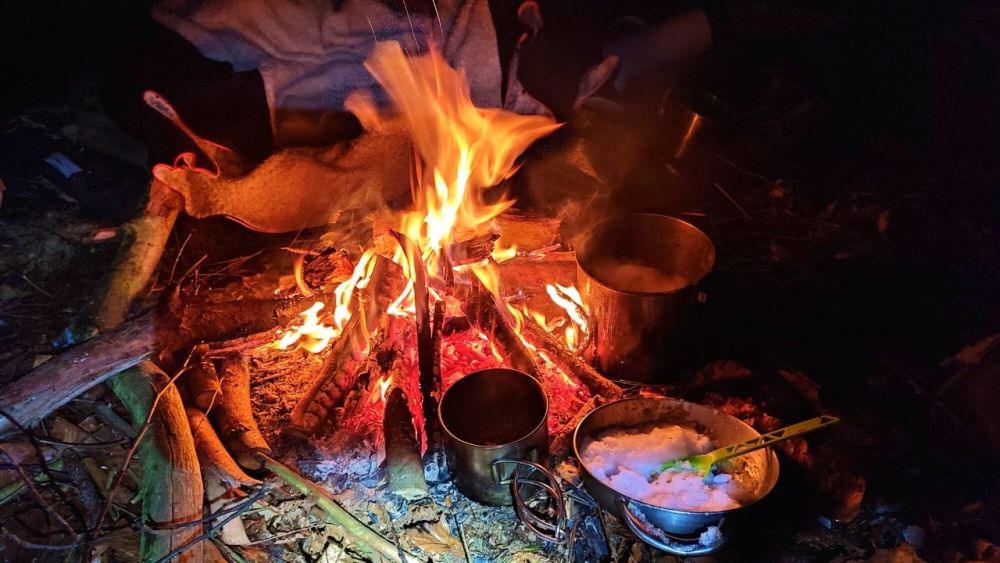
Of course, the fastest way to melt snow is by packing it into a fireproof container and placing it near your campfire. This not only melts the snow relatively quickly, but also warms up the water, providing you with warmth from the inside when you drink it, instead of making you shiver.
Additionally, you free the snow and thus the water from annoying germs, in case contamination is present. Ideally, you should boil the snow or water before drinking it.
Imagine boiling some water to enjoy a good cup of tea – it's similar here. You benefit from both the warmth and the decontamination of the water.
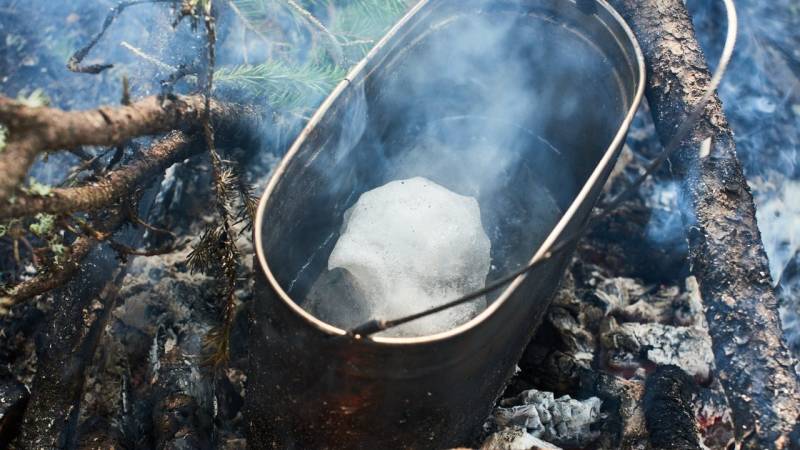
If you don't have a fireproof container, you can still melt snow at the campfire. And this method is particularly suitable for powder snow: grab a sock or a piece of fabric and wrap the snow in it. Then hang the piece of fabric with the snow in it near the campfire. You will see the snow melt, and you can catch it at the bottom with a container.
Another, even easier method is to form a snowball the size of your hand and stick it on a stick. Place this stick near the campfire as well. Insert the stick at an angle into the ground, so the snow drips into your container below.
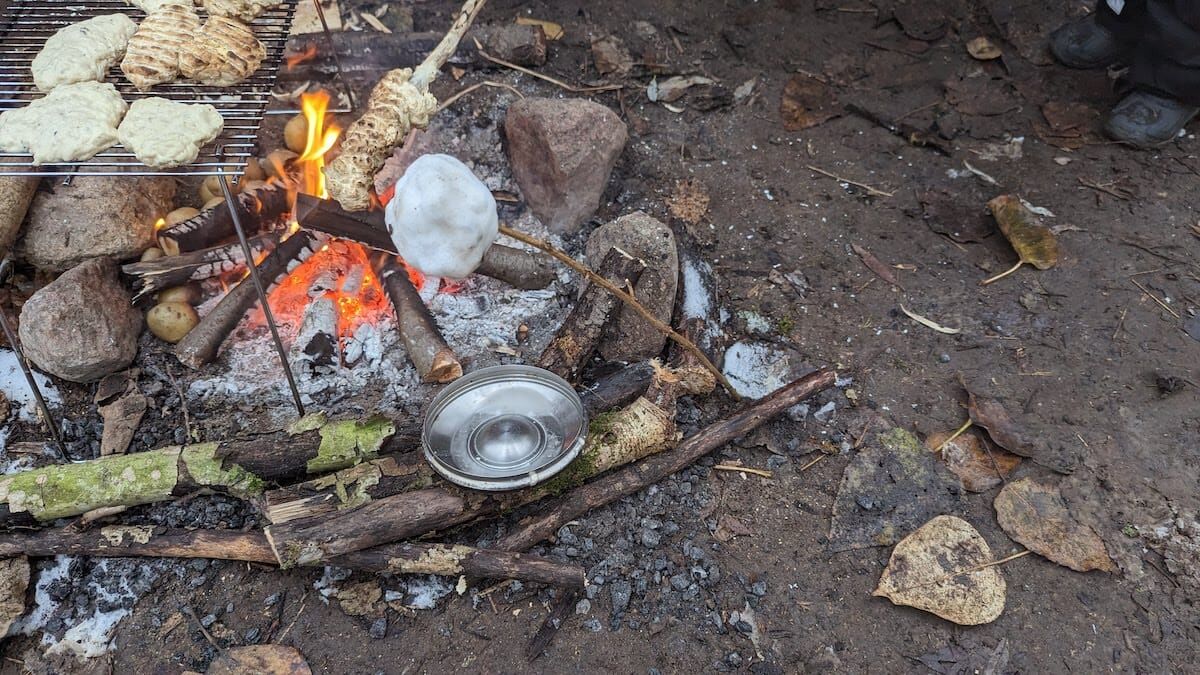
Attention: In the last two methods, where the snow is only melted but not brought to a boil, the snow is not disinfected.
You don't have a campfire nearby or no way to heat water with flames? Don't worry, there are solutions for this too. You don't necessarily need a fire to melt the surrounding snow. Although the decontaminating effect is lost, this is about your life. Everything should be fine as long as you don't eat yellow snow. ;-)
Read also
Boiling water without a pot: These 8 methods will help you get potable water – What do you do when you require water, but there is no pot or container nearby to boil it? Take a look at these 8 survival methods.
Melting snow without a fire source
What do you think is the best way to melt snow without using a fire? Right, use your own body heat!
Even if you're shivering, your body will still produce enough heat to melt the snow. Of course, you shouldn't just put it in your pockets, but proceed cleverly.
Take a water bottle or other closed container and fill it with snow. Then put this container in a pocket near your body.
However, make sure that the container is not directly on your body or skin, but there are enough layers in between to block the cold. Otherwise, the danger of hypothermia arises again.
If you happen to be in a period of sunshine, you can also place the snow-filled container (ideally transparent) in direct sunlight.
If it gets warm enough, you can still get access to water without melting snow. If you have a metal plate or other reflective surface, even better! This will accelerate the process even more.
Harvest Fresh Snow
I want to discuss possible contamination again.
Especially when you can't start a fire and boil water, it's even more important to pay attention to the cleanliness and purity of the snow.
You would rather not endanger your health in the long run.
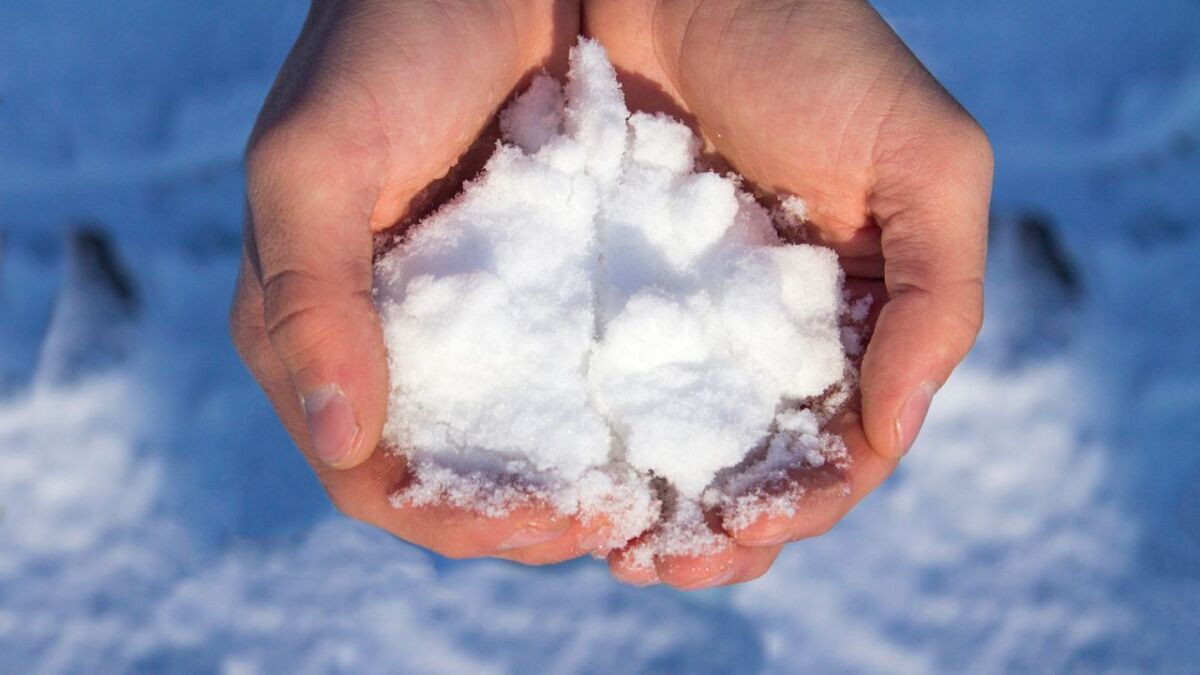
As mentioned before, snow with strong discolorations is strictly off-limits, always and everywhere. Unfortunately, even microscopic impurities can be present in seemingly clean snow and cause harm.
Let's face it: You won't always be able to distinguish between clean and contaminated, sometimes you just get lucky or unlucky.
Still, to minimize this risk, you should focus on freshly fallen, untouched snow.
Take this snow for your fluid intake and be careful when scooping it up. Ideally, you only "harvest" the top, freshly fallen layer without mixing it with deeper layers or even dirt.
The logic behind it: If the snow has just fallen, not many critters will have walked, done their business, or died on it yet. Therefore, it should also be germ-free or at least low in germs.
If you have the opportunity, you can also prevent snow from falling to the ground with a base and then collect it. At first glance, this may seem strange, but it is by no means an absurd idea. Consider that you want to collect as much clean snow as possible to ensure your fluid intake in the long term.
Is it okay to drink only water from snow?
You are surrounded by a lot of snow and can make a fire. That sounds good, right? Your water supply with drinking water is therefore secured.
Unfortunately, it's not quite enough because fresh snow contains almost no minerals or electrolytes.
That's why melted snow resembles distilled water. And if you only consume distilled water, your body won't get any minerals or electrolytes. On the contrary, they are even withdrawn from the body, and the remainder is eliminated.
If you eat enough food during this time, which contains minerals and electrolytes, it is not a problem. However, if you do this over several weeks, you will have to add minerals and electrolytes to your water.
Read also
How to Mineralize Distilled Water? - Is remineralization of distilled water necessary? Are there any side effects if it is not mineralized again? Let's clarify the questions.
Questions and answers about eating snow

Is it healthy to eat snow?
There is no definitive answer to this question as it depends on a variety of factors, such as the degree of pollution in the area where the snow comes from, and how clean the snow is. Generally, consuming snow is not considered to be harmful to your health.
What happens to your body when you eat snow?
When you eat snow, your body has to work harder to melt the snow and warm it up to body temperature, which leads to burning more energy and calories. In the worst case, it can lower your body temperature, which can be life-threatening.
Can you drink boiled snow?
Yes, you can drink snow that has been boiled. Boiling the snow kills all the bacteria and viruses that may be present in the snow, making it safe to drink.
What is in snow?
Snow contains water in the form of ice. Additionally, there are small dirt and dust particles.
Does snow contain pollutants?
Snow can contain pollutants. For example, when cars drive on roads, they emit emissions that can enter into the snow.
What happens if you eat too much snow?
If you eat too much snow, you can get stomach aches from the cold. Moreover, your body cools down, which can be life-threatening in an emergency.
Does snow have nutrients?
There is no definitive answer to this question, as it depends on the type of snow and its place of origin. Some types of snow may contain small amounts of nutrients, while others may be completely nutrient-free. However, generally, it can be said with certainty that snow is not a significant source of nutrients.
Can my child eat snow?
Basically, a child can try snow. However, it is important to make sure that the snow is clean and safe to eat.
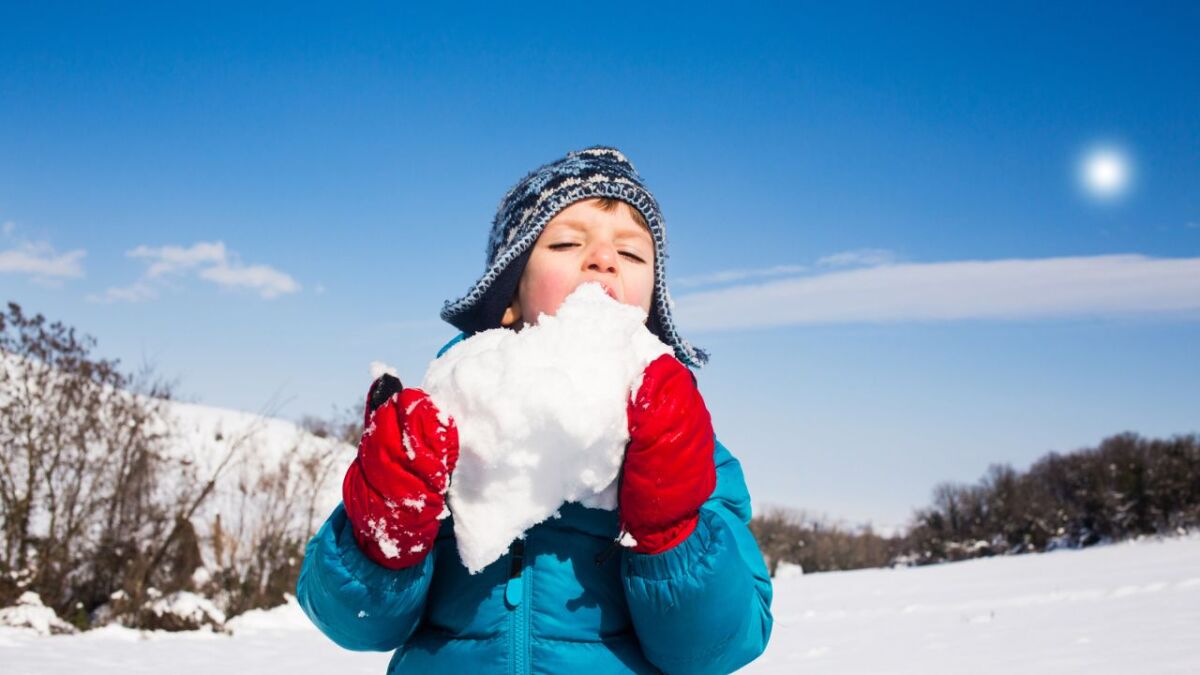
Conclusion: Yes, you can eat snow, but you should only do it literally in exceptional cases
Basically, you can use snow as a source of liquid.
After all, it is nothing more than frozen water that is freely available to you. However, you must consider all conceivable risks, including the degree of contamination and the risk of hypothermia.
You should avoid literally “eating” raw snow if at all possible.
Only if you are so dehydrated that you may only last a few more minutes without collapsing can you take the risk. At the brink of death, every straw you can grab counts.
Otherwise, always make sure to warm up the snow beforehand and melt it to make it drinkable. Ideally, you do this by using fire to remove contamination and impurities by boiling. If that's not possible, use your body heat or sunlight.
If you do decide to make snow drinkable for yourself, then choose freshly fallen, untouched snow primarily. This way, you reduce the risk of contamination again to a minimum.
As a concluding warning from me:
In all seriousness, ensuring hydration through snow should be considered a last resort and should not be the rule.
You simply cannot always factor in or minimize all risks to the extent that they pose no danger at all.
Therefore, always make sure you have a sufficient supply of liquids, which ideally you carry with you at all times. Use snow either as a reserve, if you have enough time to melt and boil it beforehand, or in an absolute emergency where it concerns life and death.
I hope that in this post you were able to learn some new things that will help you on your journey and make you a bit wiser. Thank you for taking the time to read and for your trust. Remember: always stay safe and attentive.


Author of the guide
Martin Gebhardt
Hey, I'm Martin. On my blog, you will learn the basics and numerous details about living in the wild. I think survival, bushcraft and the good life in nature are the keys to happiness. Find me here on Instagram or on YouTube. You can find more about my mission on the About Me page.
Was this guide helpful?
18 people found this guide helpful.
5.00 out of 5 points (18 Ratings)
Comments (0)
This post may contain affiliate links. So if you click on the links and make a purchase, I will receive a small commission at no additional cost to you. Click here, to learn more about it.



